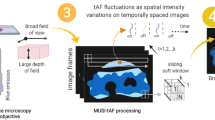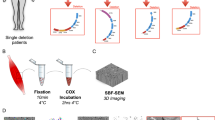Abstract
WHEN one examines the cross-section of a muscle fibre with the electron microscope, a ‘membrane-complex’1 of the type shown in Fig. 1 is observed, consisting of two dense layers separated by a light zone of about 200–300A. width. The sections shown in Figs. 1–3 has been fixed in osmium tetraoxide and stained with phosphotungstic acid in alcohol. (All scales equal 1µ.) There are reasons for regarding only the inner layer as a ‘physiological’ cell membrane and the outer layer as an extra-cellular component, frequently described as a ‘basement membrane’2. Some authors even regard the outer layer as a fixation artefact. The two layers can be distinguished, not only by their different appearance (the outer layer is more ‘fuzzy’, tending to fray out and connect with fine connective tissue fibrils), but also by their different ‘electron-staining’ properties. Thus, in permanganate preparations in which cellular and mitochondrial membranes show up in good contrast, the outer layer is usually barely visible, and in general, its relative density under different conditions of fixation and staining corresponds more closely to that of the protein filaments in the muscle fibre than to the cellular or intra-cellular membrane structures in muscle, nerve or Schwann cells (Birks, Huxley & Katz, unpublished work).
This is a preview of subscription content, access via your institution
Access options
Subscribe to this journal
Receive 51 print issues and online access
$199.00 per year
only $3.90 per issue
Buy this article
- Purchase on SpringerLink
- Instant access to full article PDF
Prices may be subject to local taxes which are calculated during checkout
Similar content being viewed by others
References
Robertson, J. D., J. Biophys. Biochem. Cytol., 2, 369 (1956).
Robertson, J. D., ‘Biochem. Soc. Sympos.’, 16, 3 (1959).
Robertson, J. D., J. Biophys. Biochem. Cytol., 2, 381 (1956).
Author information
Authors and Affiliations
Rights and permissions
About this article
Cite this article
BIRKS, R., KATZ, B. & MILEDI, R. Dissociation of the ‘Surface Membrane Complex’ in Atrophic Muscle Fibres. Nature 184, 1507–1508 (1959). https://doi.org/10.1038/1841507a0
Issue date:
DOI: https://doi.org/10.1038/1841507a0
This article is cited by
-
Modifications in myotendinous junction structure following denervation
Acta Neuropathologica (1992)
-
Sprouting and regression of the nerve at the frog neuromuscular junction in normal conditions and after prolonged paralysis with curare
Journal of Neurocytology (1980)
-
Some ultrastructural observations on the denervated skeletal muscle of frog
Experientia (1979)
-
“Disjunction” of Frog Neuromuscular Synapses by Treatment with Proteolytic Enzymes
Nature New Biology (1971)
-
An electron microscopic study of skeletal muscle from cases of the Kugelberg-Welander syndrome
Acta Neuropathologica (1971)



